Spoiler Alert! If you haven’t read the December 1973 issue of Captain America And The Falcon (#168) yet, this article contains detailed information about the plot and storyline! Don’t come complaining later if you ruined it for yourself!
Now, with that out of the way, let’s take a look at some comics! Recently, I came across a good-sized lot of Captain America And The Falcon comics from the early to late Seventies. Forty-two issues spanning a solid seven years of Captain America with a fair number of gaps of course. Like a lot of kids, I grew up reading the occasional Cap story, but I never really collected it. I picked up this run because a fair chunk of the later issues was the final run written and drawn by none other than Jack ‘The King” Kirby himself, almost twenty issues. Most of the earlier issues were written by an assortment of writers including Stan Lee, Roy Thomas, Tony Isabella, and even Marv Wolfman. Having never had access to this much Cap before, I figured I was in for a treat. What I hadn’t expected was what a surprise I was in for as well.
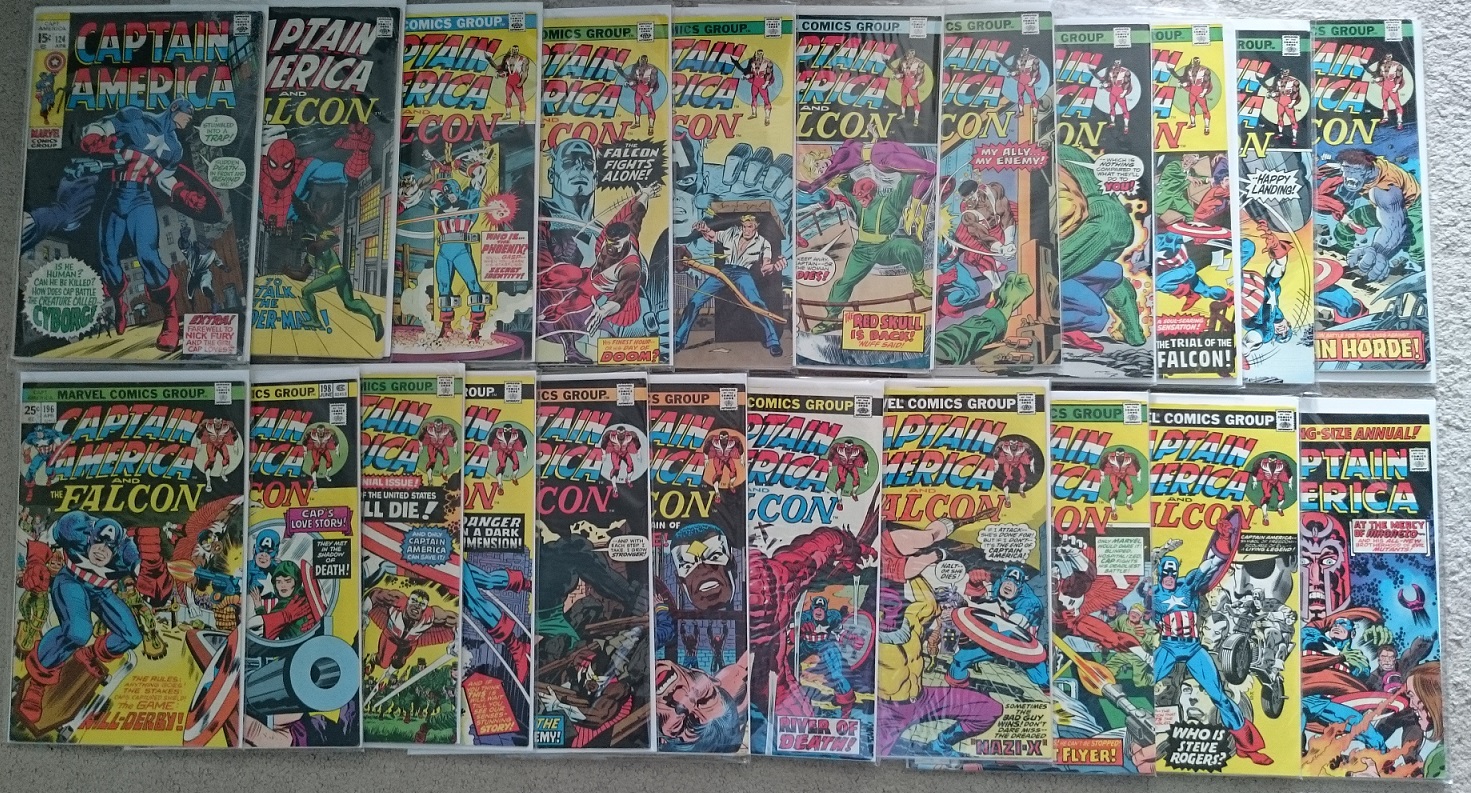
I read a lot of Marvel Comics as a kid. My favorite was Spider-Man. Most of my comic collection as a child consisted of Marvel and DC from the Seventies and Eighties. But I read those comics with a child’s eyes. Coming back to them as an adult and reading them with an adult’s perspective shows a complex multi-layered dynamic between the characters that I’ve never realized existed before. It’s something that isn’t in a lot of today’s modern comics; a subtext commentary about our society at the time the books were written. It turns out Captain America And The Falcon was a book that was notably not afraid to address the issues of the day, namely racism and the inequity between blacks and whites in 1970s America. There are comments and statements throughout the book, often between Cap and Falcon, about how African-Americans are treated in the USA. It’s not just here or there either. Stan Lee addresses it, Jack Kirby addresses it and bringing us to Captain America And The Falcon #168, Roy Thomas & Tony Isabella address it.
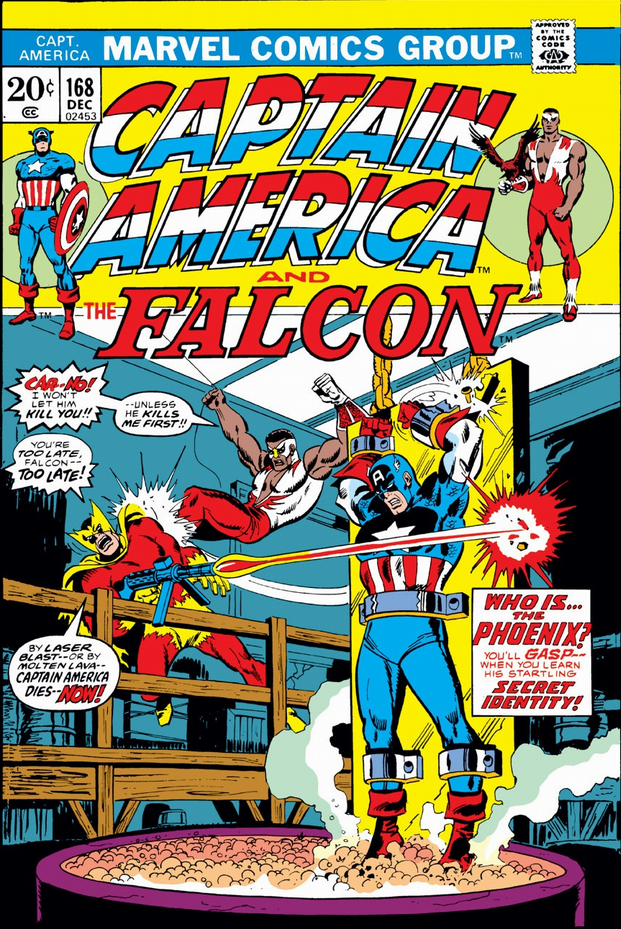
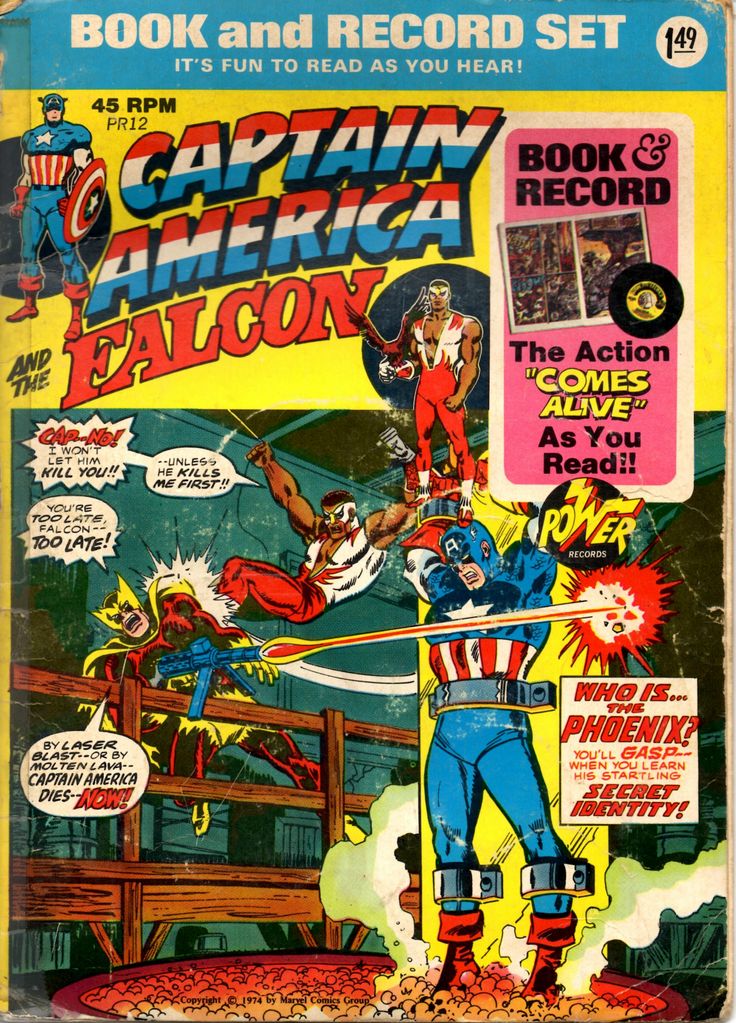
This issue of Captain America caught my attention, not just for the iconic cover, but also because it was a self-contained one issue story that was made into a Book And Record set which I happened to own as a child. I’ve probably read the entire book at least fifty times, but having lost my Book and Record collection over the years, I’d almost forgotten that the story existed and had no idea that it was actually a regular issue that was released in the early Seventies as well. So over twenty years later, I sat down to read it again.
The story starts out with Cap and Falcon out on patrol. One of the first things you notice though is the tone of which Falcon speaks. His dialect comes out in the writing and he sounds like he’s straight off the street in the Seventies. This fits of course, but I never noticed it as a kid. Captain America has a much more refined mode of speech but their banter back and forth flows naturally. Things got surprisingly adult very quickly though, with Steve Rogers (and if you don’t know that’s who Captain America is…well, I can’t help you. Or I just did, take your pick) worrying about the morality of having fallen in love with the daughter of the woman he used to be in love with in the 1940s. And Falcon reassures him by telling him that it’s just ‘an old-fashioned [love] triangle’ that’s got him down. Okay, so apparently that’s just par for the course for most people. Who knew?
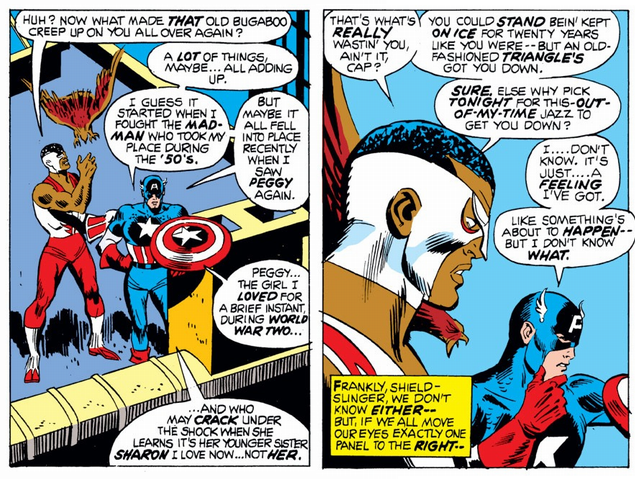
While I’m still reeling from the implications of that little bombshell, a mystery villain attacks Cap and Falcon out of the blue, spouting dire threats at Cap specifically. Here’s where things get really interesting. Falcon sneaks up on “The Phoenix” while he’s attacking Cap and kicks him in the back from behind. Standard superhero stuff. But then the Phoenix responds.
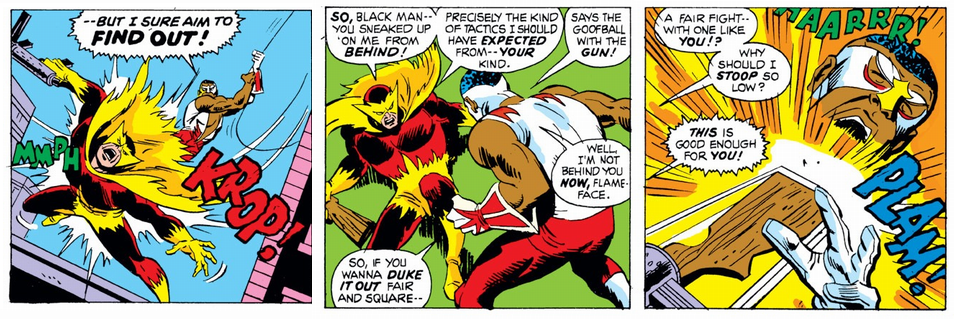
As you can see in the panel, Sam Wilson (that’s the Falcon for those of you who also didn’t know) refuses to sink to his level and makes with the witty banter in return, offering him a fair fight and the Phoenix responds again. He then proceeds to pile drive Falcon in the chin with the butt of his um…laser rifle. Yeah. In 1973. Hey, it’s a superhero comic! But as you can imagine, the above exchange left me nearly open-mouthed. Had I seriously read that dialogue properly? Apparently, I had. And make no mistake, this is a theme that is rife throughout the Captain America And The Falcon series. It’s not unique to this issue. However, they did choose to make this particular issue into a Book and Record set for kids. But don’t worry, the shocks don’t end here!
Cap then drives off Falcon to try and keep him safe and then goes hunting for the Phoenix on his own. He finds a likely victim and ends up getting captured by the villain himself. A chained Captain America asks him who he really is and why he holds such hatred for him and in true villain fashion, Phoenix gives Cap his life’s story.
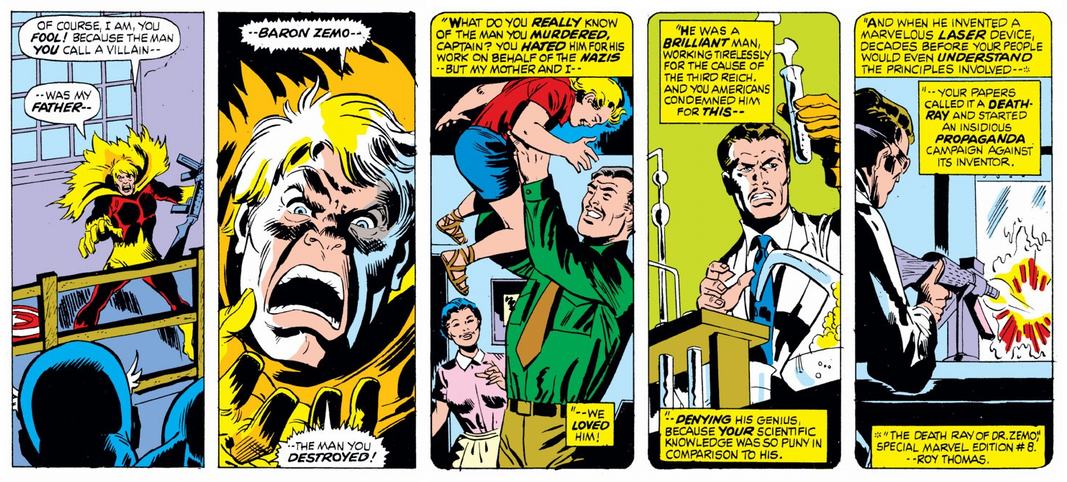
He’s the son of Baron Zemo, a Nazi scientist who worked on weapons development for the Third Reich. That’s right, Nazis.
But not just Nazis, Nazis and their families. Zemo’s son portrays his father as a loving family man, working tirelessly for the benefit of the German war effort, until an attack by the despicable Captain America bonds his mask to his face and he becomes mad with anger and revenge and turns on his family, eventually meeting his doom. Now his son is out, for blood, rising like a phoenix to wreak vengeance upon our not-so-hapless hero. Phoenix loses in the end and loses his life too. Falcon drops in to save the day, Phoenix spouts more racial epithets and Cap joins in to stop him, but his own weapons destroy him and Cap has an introspective moment about the nature of hatred. Even this scene was emotionally charged and reminds us of our history.

And as I read through more issues, the same types of themes reoccurred. One of the Kirby issues (Captain America And The Falcon #194, February 1977) has Steve dreaming about an ancestor from the American Revolution and when he tells Sam Wilson, Falcon accuses Cap’s family of owning slaves, possibly even his own ancestors! Isn’t that literally the exact thing that’s been in the news the last year or two? It’s basically a conversation about white guilt, ignorance, and forgetting the past in less than 3 paragraphs! Absolutely stunning.

Stop and think about all of this for a minute. We have the child of a Nazi following in his father’s footsteps and coming to America to assassinate Captain America. It does at least explain his brutally racist remarks to Falcon. But take this book out of context for a moment. Overlay it with the politics and mood or the country today. It’s like we never got past that era. We have the same racism. We have neo-Nazis spreading across North America and Europe like a virus. It’s FORTY-FOUR years after this comic was written and we still have the same issues for African-Americans in America as we did in 1973! It’s right there in black and white for all of us to read in a comic primarily intended for children.
If anything, in many ways things have gotten worse instead of better, but we talk about the ‘rising racial tension in America’ like it’s shocking and new. It’s not. It never left. It’s a social convention that’s been lurking about beneath the surface that we mostly avoided talking about except for the people directly suffering from it. And it’s all wrapped up in a neat little red, white, and blue package for anyone to see in a comic written before I was even born. Not in literature, nor in a journal article, or even an editorial. In a superhero comic book. THAT is how pervasive the endemic problems in our society are. THAT is what we need to realize. That every little thing shows us something is very wrong and we continue to ignore it, even in our kids’ comics. Racism, white supremacy, the changing structure of relationships and learning to accept them, none of it is new. We’ve just forgotten it isn’t. Maybe we need to look to the past and have some open discussions about these issues. Perhaps we should put aside the politically charged arguments and the political correctness and simply look at our world…through the panels of a comic book.
A final note:
For those of you who are interested, Captain America And The Falcon is not remotely the only mainstream book that handles themes like these. Marvel and DC in the 1970s both covered a variety of sociopolitical issues. Notably, Black Panther, Luke Cage, Hero For Hire, and the Power Man And Iron Fist comics for Marvel and Green Lantern/Green Arrow for DC were heavy hitters. Drugs, racism, poverty, and social inequity all get some serious contemplation between super-powered brawls. If you get the chance, take a second look at some of those old comics. You might just be surprised what’s inside them! 

